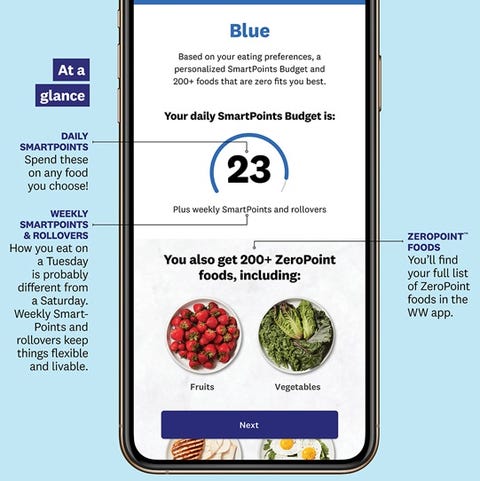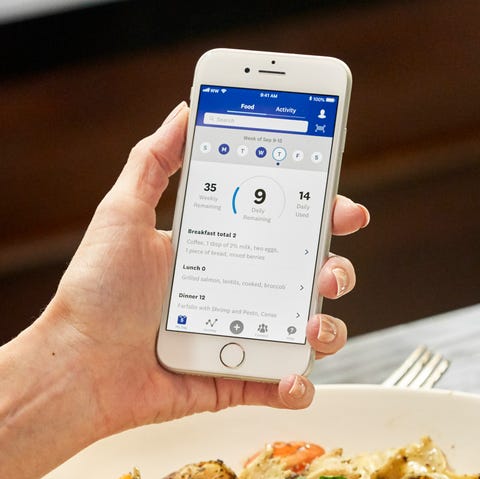What Is Weight Watchers
If you're looking for help getting started on a healthy routine in the new year, you may be considering Weight Watchers.
For many years running, the program has been recognized by analysts at the U.S. News & World Report as one of the best diets for rapid weight loss. Experts praise Weight Watchers (now formally known as WW) for its straightforward point system that allows dieters to drop a few pounds by helping you make healthy choices at mealtimes (even if you're eating out!).
Weight Watchers overhauled its diet plans in 2020, focusing on creating three subcategories for calorie counts and recipes that guided dieters to foods based on their needs. But in 2021, Weight Watchers has added a new service in addition to its signature tracking offerings that may help them stay motivated while many are still largely at home during the COVID-19 pandemic.
In fact, you don't need to head to any WW offices or in-person meetups to begin dieting with the program. In signing up for what the brand calls its Digital360 offering, you can view live and pre-recorded events and coaching sessions that are designed to motivate dieters. The Digital360 program grants dieters entrance to WW's mobile app to log all of their meals and keep track of their daily progress, all while allowing them to connect with one of many new WW coaches (or all of them at once) via their in-app updates. For an additional upcharge (starting as little as $6 per month), you can even get access to live support groups via your WW app, and schedule one-on-one consultations live with coaches and experts if you'd like. Standard access to recipes and point systems starts at just under $13 per month while one-on-one coaching services can range up well past $40 monthly.
We're exploring all of the plans available to WW dieters this year below; whether you're brand new to Weight Watchers altogether or you've already found success while on the program in years prior, here's what you need to know to get started.
Editor's note: Weight loss, health and body image are complex subjects — before deciding to go on this diet, we invite you gain a broader perspective by reading our exploration into the hazards of diet culture.
What are Weight Watchers' new meal plans?
There are three meal plans for dieters to choose from, each of which falls under the company's newer program, officially known as "MyWW." These plans are all designed to include more options than ever before, including some starch-heavy pantry staples that once cost dieters countless points in previous years. All three plans are structured around what's known as "ZeroPoint" foods, meaning you can indulge in these items without having to measure them precisely or track them in your WW app. You'll be directed to take a quiz before you enroll, as your results are used to suggest which plan might be best for you. All of the plans encourage dieters to reach for more ZeroPoint foods that won't eat into their daily point limits.

Courtesy of Weight Watchers
- Green Plan: If you're just starting your weight loss journey, this option may be best for you. There's a list of 100+ ZeroPoint vegetables and fruits that you can regularly incorporate into your meals, helping you find satiating, wholesome staples that experts believe are less likely to be overeaten. The Green Plan comes with the largest WW SmartPoints daily budget, meaning you can also enjoy more of the foods you may already be eating at home. You'll need to frequently log your meals on the WW app to maintain progress, however.
- Blue Plan: Those who have already tried Weight Watchers will be most familiar with this plan. There are 200 different items counted on this plan's list of ZeroPoint foods, which includes certain lean proteins, eggs, beans and non-fat yogurt. The trade-off? A tighter allowance on daily SmartPoints.
- Purple Plan: This plan has a very modest SmartPoints budget, but the list of ZeroPoint foods here chalks up to 300 different wholesome ingredients, so you shouldn't feel too restricted on a daily basis. This plan allows you to eat whole-wheat pasta and potatoes without adhering to strict measurements, a feature that's exciting for many new dieters.
Regardless of which plan you are enrolled in, you'll also have the choice of subscribing to WW's newest myWW+program through a variety of plans, including the standard Digital plan, the new Digital360, WW's Unlimited Workshops plan, or personal coaching, all at different costs. All of these memberships come with access to point systems, recipes, meal planners, workout and fitness tools, and app services, but here's how they differ:
- Digital360: You'll have digital access to live-streaming and pre-recorded messages, events, and coaching from a pool of WW coaches publishing content on the brand's app and website. You'll also be able to connect with other dieters in a digital social setting who are also embarking on a weight loss journey. This plan is best for those who are motivated to stay engaged, as you won't be accessing group-based workshops and check-ins. This subscription starts at over $16 per month.
- Unlimited Workshops: Whether in-person or virtually, you'll select a WW coach and join a group of dieters for weekly workshops. You can sign up for as many workshops as you'd like, and you'll also be able to connect with members in your group to share tips and tricks. Per WW's website, the price difference between this offering and Digital360 differs anywhere from $2-$3 a week, depending on your locale — plans start at $24 per month.
- 1-on-1 Coaching: The most expensive subscription, this enables you to get 1-on-1 coaching via a scheduled weekly call with your WW coach, who will also help you troubleshoot any meal plans, fitness routines, or other questions you may have about the program. You won't have access to most of the features on Digital360, however. Plans for this top-tier program start at just over $36 per month.
Whichever subscription you choose, recipes and point-counting systems are included; USA Today reports that WW's color-coded diet plans led to a 21% decrease level in hunger levels overall, per a six-month clinical trial.
This content is imported from {embed-name}. You may be able to find the same content in another format, or you may be able to find more information, at their web site.
How do these plans differ from Weight Watchers' Freestyle?
You won't be able to find the Freestyle program on WW's sign up page, but rest easy: The Blue Plan is largely the same as the previous Freestyle program. Just like with Freestyle, all new dieters will start by taking a personalized assessment, which enables you to choose the best plan for your desired results. But the ZeroPoints list of foods and overall SmartPoints structure associated with the Freestyle plan has been largely rolled into myWW Blue. You can sign up for that program right now—or get started on any of WW's newest diet plans by taking your personalized diet assessment right here.

Mister Lynch via WW USA
Are Weight Watchers' new plans healthy?
Unlike other diet programs, Weight Watchers doesn't harp on restricting your choices when it comes to food staples, and it emphasizes the importance of portion control and leaning on wholesome ingredients. Plus, it stresses weight loss over a longer period of time: the WW website maintains that members should expect to lose anywhere from one-half to two pounds each week on the plan. The addition of three different plans to add more customization is promising, says Los Angeles-based performance nutritionist Cynthia Sass, MPH, RD, CSSD. Like many other health experts, Sass believes that one diet doesn't "fit" all. "I think that customizing an eating strategy to better fit what's realistic, doable, and sustainable for you will likely lead to better long term results."
More importantly, however, numerous clinical studies have shown that WW's diet programs support healthy weight loss that dieters can maintain. The results from a 2017 clinical trial published in The Lancet shows that obese adults who followed a WW program for one full year lost more weight than those who used self-help materials; plus, these adults were better able to maintain their weight loss over two years. A separate review of 39 different studies published in 2015 in the Annals of Internal Medicine, found that those who followed a WW program lost nearly 3% more weight compared to those who received other forms of counseling.
With the research in mind, Sass still says that Weight Watchers may be flawed in that some dieters may still end up eating too many over-processed foods due to their point allowance. "With my clients, I emphasize choosing primarily unprocessed foods, as well as macronutrient balance, and consistency," she shares. "I've seen people 'save' up their points for big splurges, which throws off balance in the long run... It's important to examine what feels like a good fit for you, and find a strategy you can continue to follow long term, as a lifestyle, not a short-term 'diet.'"
And while much of the research conducted on Weight Watchers' programs in the past closely examined those who attended in-person meetings, Sass says that starting with a digital-only plan may actually be a better way to truly glean learnings from the program. "I think that for some people an app can actually be more effective. If you're already tech-savvy and keep your phone at your fingertips, it may be one of the primary ways you receive information."
Zee Krstic Associate Health Editor Zee Krstic is a health editor for GoodHousekeeping.com, where he covers the latest in health and nutrition news, decodes diet and fitness trends, and reviews the best products in the wellness aisle.
This content is created and maintained by a third party, and imported onto this page to help users provide their email addresses. You may be able to find more information about this and similar content at piano.io
Source: https://www.goodhousekeeping.com/health/diet-nutrition/a30381252/new-weight-watchers-program-2020/







Tidak ada komentar:
Posting Komentar